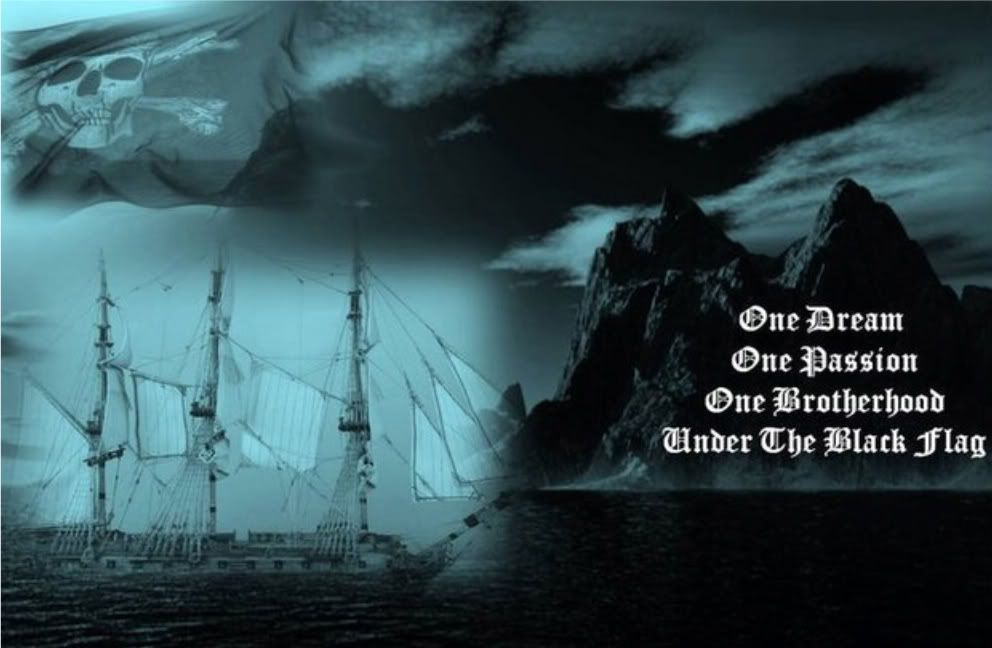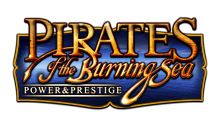Pirate Clothin
1:55 μ.μ.
TheGolden Age of Pirates! The pirates who operated during the Age of Explorationhave become synonymous with a definite style of Pirate Clothing.But what pirate clothing was fact and what pirate clothing was fiction? Thelegendary apparel of a pirate has created a pirate stereotype. But much of thepirate clothing was developed through necessity and befitted the lifestyle of apirate seaman.
PirateClothing - the 'Slops'
Many pirates were recruited from unemployed seaman - there was plenty of workfor a fighting sailor during times of was but during peacetime the seamanbecame impoverished and turned to a life of piracy. In 1628 the BritishAdmiralty established sailor's clothing (which were called 'slops') to be wornby men who had been press-ganged. This type of clothing consisted of a canvas doublet and breeches, knitted caps called Monmouth caps, cottonwaistcoats and drawers, stockings, linen shirts and shoes. So much of thisclothing was adopted by the seamen who turned to the life of a pirate.
Many pirates were recruited from unemployed seaman - there was plenty of workfor a fighting sailor during times of was but during peacetime the seamanbecame impoverished and turned to a life of piracy. In 1628 the BritishAdmiralty established sailor's clothing (which were called 'slops') to be wornby men who had been press-ganged. This type of clothing consisted of a canvas doublet and breeches, knitted caps called Monmouth caps, cottonwaistcoats and drawers, stockings, linen shirts and shoes. So much of thisclothing was adopted by the seamen who turned to the life of a pirate.
PirateClothing - the Monmouth Cap and the Elizabethan Sumptuary Laws
The woollen cap referred to as the Monmouth Cap dates back to the 1500's. In1571 the Elizabethan Sumptuary Laws were passed which ordered everyone over the ageof six to wear a woollen cap on Sundays and holidays in order to helpEngland
The woollen cap referred to as the Monmouth Cap dates back to the 1500's. In1571 the Elizabethan Sumptuary Laws were passed which ordered everyone over the ageof six to wear a woollen cap on Sundays and holidays in order to help
PirateClothing - Flouting the Elizabethan Sumptuary Laws!
Elizabethan Sumptuary Laws dictated what color of clothing and the materialsand fabrics which could be used for each social level. The ElizabethanSumptuary Laws therefore enforced what clothing individuals were allowed to ownand wear, an easy and immediate way to identify rank and privilege. Pirateclothing, especially that of the successful and wealthy pirates took greatdelight in flouting the Elizabethan Sumptuary Laws! Anything went - finevelvets and silks and such fabrics which had been previously banned to anyoneother than those in the Upper Classes.
Elizabethan Sumptuary Laws dictated what color of clothing and the materialsand fabrics which could be used for each social level. The ElizabethanSumptuary Laws therefore enforced what clothing individuals were allowed to ownand wear, an easy and immediate way to identify rank and privilege. Pirateclothing, especially that of the successful and wealthy pirates took greatdelight in flouting the Elizabethan Sumptuary Laws! Anything went - finevelvets and silks and such fabrics which had been previously banned to anyoneother than those in the Upper Classes.
PirateClothing - The Motley Crew
The fabrics used in pirate clothing depended on how wealthy they were and whatclothing had been stolen! Pirate clothing for the ordinary seamen was thereforeoften ill-fitting! Motley was a multi-colored woollen fabric woven of mixedthreads in 14th to 17th centuryEngland
The fabrics used in pirate clothing depended on how wealthy they were and whatclothing had been stolen! Pirate clothing for the ordinary seamen was thereforeoften ill-fitting! Motley was a multi-colored woollen fabric woven of mixedthreads in 14th to 17th century
PirateClothing - the Fabrics and Materials
The fabrics used in pirate clothing depended on how wealthy they were and whatclothing had been stolen! But basically there were no rules! The practicalfabrics used for ordinary pirate clothing included canvass, leather, wool,linen, cotton and sheepskin. The fabrics and materials used in pirate clothingwhen on shore, or by the Pirate Captain, were far more flamboyant andexpensive. Velvet, silk, damask, sarcanet, camlet and taffeta were included inthe fabrics and materials used for this type of pirate clothing - exoticfeathers were also favored!
The fabrics used in pirate clothing depended on how wealthy they were and whatclothing had been stolen! But basically there were no rules! The practicalfabrics used for ordinary pirate clothing included canvass, leather, wool,linen, cotton and sheepskin. The fabrics and materials used in pirate clothingwhen on shore, or by the Pirate Captain, were far more flamboyant andexpensive. Velvet, silk, damask, sarcanet, camlet and taffeta were included inthe fabrics and materials used for this type of pirate clothing - exoticfeathers were also favored!
PirateClothing - Colors
The colors of pirate clothing included the colors which had previously bannedby the Elizabethan Sumptuary Laws. Crimson, violet, purple and deep bluewere typical of the colors which had previously banned for anyone other thanthe Upper Classes!
The colors of pirate clothing included the colors which had previously bannedby the Elizabethan Sumptuary Laws. Crimson, violet, purple and deep bluewere typical of the colors which had previously banned for anyone other thanthe Upper Classes!
PirateClothing - The clothes worn by a Pirate Captain
The typical clothes worn by a Pirate Captain are illustrated in a descriptionof the clothing worn by Black Bart (Bartholomew Roberts). He was described asflamboyant dresser. His waistcoat and breeches were made of velvet in a richcrimson color. His hat was decorated with an exotic red feather. An expensivesatin and leather sash diagonally decorated the front of his coat and a sashwas tied around his waist. The clothes of this pirate captain were adorned withgold jewellery and ornaments.
The typical clothes worn by a Pirate Captain are illustrated in a descriptionof the clothing worn by Black Bart (Bartholomew Roberts). He was described asflamboyant dresser. His waistcoat and breeches were made of velvet in a richcrimson color. His hat was decorated with an exotic red feather. An expensivesatin and leather sash diagonally decorated the front of his coat and a sashwas tied around his waist. The clothes of this pirate captain were adorned withgold jewellery and ornaments.
List ofPirate Clothing
Thefollowing list details the items of pirate clothing and some interesting factsand information about various items of Pirate Clothing:
Motleyclothing - bright mis-matched colors
Bandana- A pirate clothing item which kept the sweat out of the pirate's eyes
Tri-corneredhat - made of various materials including leather
Doubletor coat - Expensive item of pirate clothing. Long clothes, including thedoublet were a style of pirate clothing best suited to land. Decorated withornate braids and fabrics
Breeches- trousers were generally only worn by English pirates
Knittedcaps called Monmouth caps
Waistcoats- flamboyant addition to pirate clothing
Drawers- tight fitting to allow for the difficult tasks of a pirate
Stockings- Woollen stockings for practical apparel and silk for land use
Shirts- The puffed sleeves were suited to pirate clothing on land
PirateClothing - the Accessories
The famous accessories of pirate clothing!
The famous accessories of pirate clothing!
GoldHoop Earrings - A sign of wealth but also believed to serve a practicalpurpose in easing sea sickness by applying pressure to ear lobes!
Bracelets,chains, pins and pendants - Gold, silver, precious jewels and pearls
Sash -Alsio called a baldric made of fine fabrics, sometimes overlayed with a leathersash to take the weight of pirate weapons
Braidsand ribbons - adorned various elements of pirate clothing but were also used tobraid a pirate beard or hair. Blackbeard was famous for tying black braids tohis beard and hair and famous for sticking lighted matches under his hat oneither side of his face to terrify his enemies
PirateBoots - Ranged from bootcovers, to Bucket boots up to thigh-high boots, Pirateseamen often went barefoot - a practical decision when a task might include'swabbing the deck'
Piratebelts - these wide belts were worn around the waist and diagonally across theshoulder in order to take the weight of pirate weapons
Buckles- Ornate buckles were used to adorn pirate belts and shoes
Fancybuttons - a decorative addition to pirate clothing
Scarves- a flamboyant addition to pirate clothing
Wigs -stolen or purpose made - favored by Pirate captains
PirateClothing - the Weapons
The famous weapons which accompanied pirate clothing!
The famous weapons which accompanied pirate clothing!
Thepirate cutlass - A heavy curved sword with only one, but deadly, cutting edge
Daggers- often held in the leather sahes or belts
Pistols
PirateClothing - the Stereotype Pirate
All of the items of pirate clothing have been covered but other elements becamesynonymous with the pirate. These related to the injuries which befell men whofollowed the pirate's life. Fighting was an important skill but inevitablypirates were wounded. Pirates lost eyes during battle - hence the famous pirateeye patch. Limbs were often amputated as the only resort for a badly injuredleg - hence the wooden peg leg. Hands which were lost were replaced with hooks.
All of the items of pirate clothing have been covered but other elements becamesynonymous with the pirate. These related to the injuries which befell men whofollowed the pirate's life. Fighting was an important skill but inevitablypirates were wounded. Pirates lost eyes during battle - hence the famous pirateeye patch. Limbs were often amputated as the only resort for a badly injuredleg - hence the wooden peg leg. Hands which were lost were replaced with hooks.













